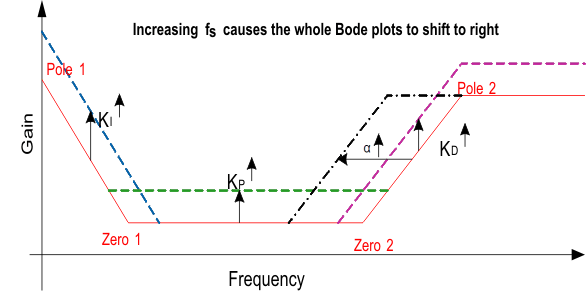SLUU885C March 2012 – June 2024 UCD3138 , UCD3138064 , UCD3138064A , UCD3138128 , UCD3138A , UCD3138A64
- 1
- 2
- Abstract
- 1 Introduction
- 2 Description
- 3 Electrical Performance Specifications
- 4 Schematics
- 5 Test Setup
- 6 List of Test Points
- 7 List of Terminals
- 8 Test Procedure
- 9 Performance Data and Typical Characteristic Curves
- 10EVM Assembly Drawing and PCB Layout
- 11List of Materials
- 12Digital PFC Description
- 13Evaluating the Single-Phase PFC with GUI
- 14Monitoring, Re-configuring and Re-tuning with Designer GUI
- 15Digital PFC Firmware Development
- 16References
- 17Revision History
12.9.2 Feedback Loop Compenstaion Tuning with PID Coefficients
When fine tuning the feedback control loop, one would like to know each parameter in PID how to affect the control loop characteristics without going through complicated description of the above equations. Table 12-2 below helps this and is visually shown in Figure 12-16.
Table 12-2 Tuning with PID Coefficients
| Control Parameters | Impact on bode plot |
| KP | Increasing KP |
| • | Pushes up the minimum gain between the two zeros. |
| • | Moves the two zeros apart. |
| KI | Increasing KI |
| • | Pushes up integration curve at low frequencies. |
| • | Gives a higher low frequency gain. |
| • | Moves the first zero to the right. |
| KD | Increasing KD |
| • | Shifts the second zero left. |
| • | Does not impact the second pole. |
| α | Increasing α |
| • | Shifts the second pole to the right. |
| • | Shifts the second zero to the right. |
| Ts = 1 / fs | Increasing the sampling frequency fs : |
| • | Causes the whole Bode plot to shift to right. |
 Figure 12-16 Tuning PID Parameters
Figure 12-16 Tuning PID Parameters